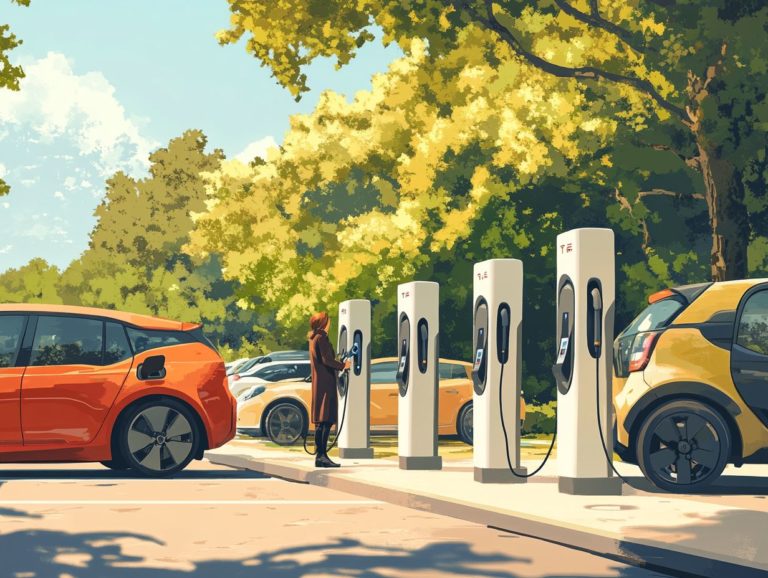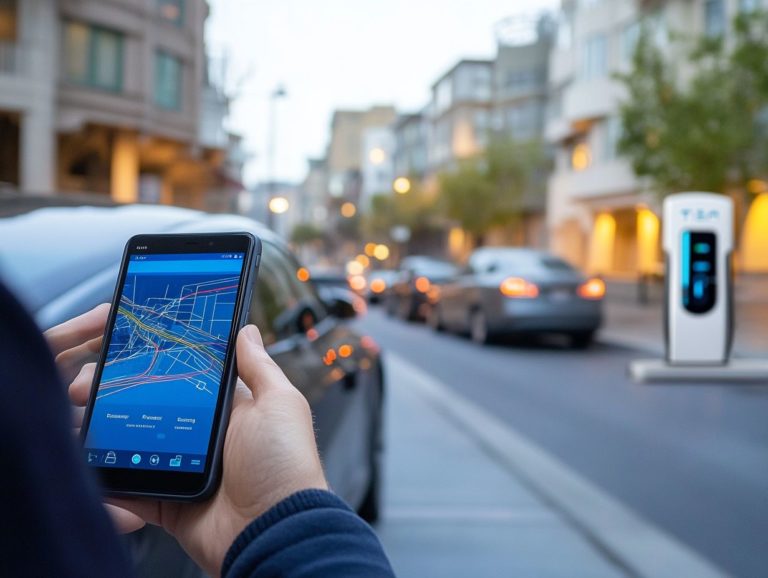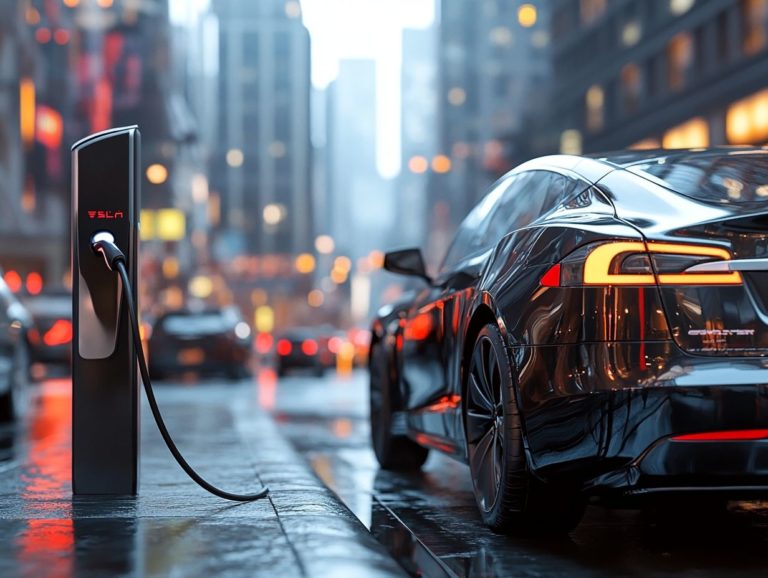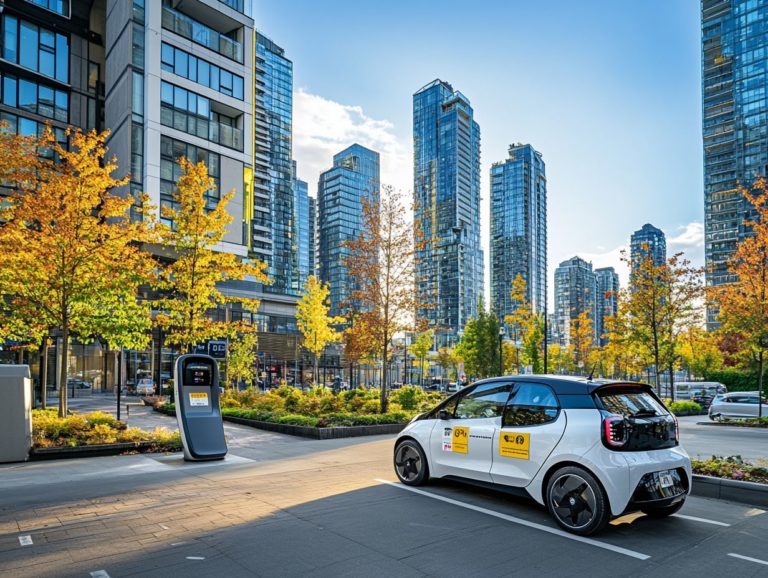The Top Features of 2024’s EV Models
As electric vehicles (EVs) reshape the automotive landscape, 2024 is set to deliver a plethora of exciting advancements!
You can expect longer driving ranges, quicker charging times, and better safety features, all wrapped in sleek, modern designs. This year s EV models are sure to captivate both experienced drivers and those just stepping into the electric realm.
You ll discover the top features making waves in the industry while examining potential drawbacks, environmental benefits, and the driving forces propelling this electric revolution.
Get ready for an enlightening journey into the future of transportation!
Contents
- 1. Longer Driving Range
- 2. Faster Charging Times
- 3. Enhanced Safety Features
- 4. Improved Battery Technology
- 5. More Affordable Prices
- 6. Increased Availability
- 7. Sleeker and More Modern Designs
- 8. Advanced Driver Assistance Systems
- 9. Wireless Charging Options
- 10. Integration with Smart Home Technology
- 11. Improved Performance and Acceleration
- 12. Increased Number of Electric Models
- 13. More Sustainable Materials Used
- 14. Improved Connectivity Features
- 15. Government Incentives and Support for EVs
- What Are the Main Benefits of Owning an EV?
- Frequently Asked Questions
- What are some of the top features of 2024’s EV models?
- Will the driving range of 2024’s EV models be significantly longer?
- How will the charging times of 2024’s EV models compare to current models?
- What safety features can we expect to see in 2024’s EV models?
- Will there be any improvements in battery technology for 2024’s EV models?
- How will connectivity options in 2024’s EV models be different from current models?
Key Takeaways:
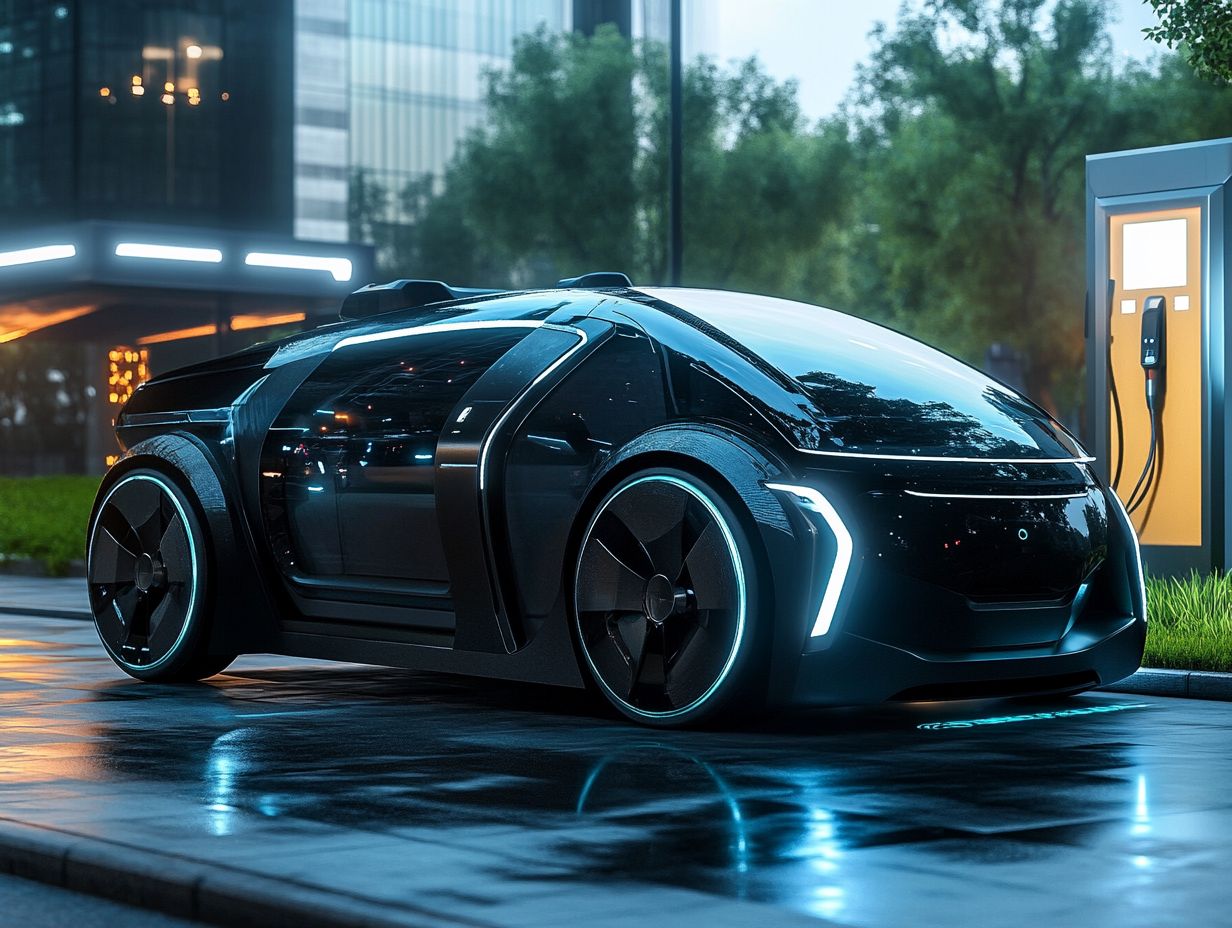
2024’s electric vehicle models will have longer driving ranges, allowing for longer trips without needing to recharge.
Faster charging times will make owning an EV more convenient for busy individuals.
Better safety features, such as advanced driver assistance systems, will make EVs a safer option for drivers and passengers.
1. Longer Driving Range
In the world of electric vehicles (EVs), you’ll find that longer driving ranges are essential for consumer adoption. This is especially true for models like the Tesla Model 3 and Hyundai Ioniq 5, which help eliminate range anxiety for those contemplating the shift from combustion engines to electric.
Recent advancements in battery technology play a crucial role in this transformation. Take the Tesla Model Y, for example; it boasts remarkable efficiency and an expanded battery capacity, enabling you to cover greater distances on a single charge.
The Porsche Taycan exemplifies cutting-edge battery design by delivering high performance alongside enhanced range. These innovations elevate your driving experience and address concerns about frequent charging.
As the industry evolves, optimizing battery life and charging speed continues to bolster consumer confidence, making EVs an increasingly viable option for your everyday needs.
2. Faster Charging Times
Faster charging times are transforming the electric vehicle landscape, allowing you to recharge your EV efficiently at charging stations. This innovation makes electric cars, like the Tesla Model Y, increasingly appealing to both eco-adventurers and daily commuters.
With the rise of various fast charging technologies such as Level 3 DC fast charging and innovative V2L bidirectional charging you’ll discover more ways to seamlessly integrate electric vehicles into your lifestyle. A robust charging network is essential for effortless travel, especially in urban areas where the charging infrastructure must keep up with growing demand.
This interconnected system enhances convenience and instills confidence among potential buyers, smoothing the transition to electric vehicles.
As a result, greater adoption of EVs will pave the way for more sustainable practices, ultimately contributing to a greener and brighter future.
3. Enhanced Safety Features
You ll notice better safety features in electric vehicles, like those in the Tesla lineup, the BMW i7, and the Rivian R1T. These vehicles come equipped with advanced driver aid technologies that prioritize passenger protection and accident prevention.
They feature state-of-the-art automatic emergency braking systems, capable of detecting potential collisions and applying the brakes automatically if you don t respond in time. Lane-keeping assist helps keep you centered in your lane, significantly lowering the chances of unintentional lane departure. Additionally, advanced airbag systems are evolving to offer more protection across various crash scenarios, ensuring every passenger is secure.
These features align seamlessly with EPA emissions standards, elevating safety measures while satisfying your growing expectations for eco-friendliness and cutting-edge technology in your driving experience.
Stay tuned for more updates on electric vehicles!
4. Improved Battery Technology
Improved battery technology is revolutionizing the electric vehicle sector, enabling manufacturers like Lucid to create models that deliver exceptional performance, enhanced energy efficiency, and extended lifespans all thanks to advancements in battery size and electric powertrain design.
The latest breakthroughs, especially in solid-state batteries (a new kind of battery that offers better performance), indicate big changes in technology that not only improve range but also significantly cut down charging times. These innovations promise higher energy densities, meaning you can travel further on a single charge helping ease worries about running out of battery.
Faster charging makes electric cars more enjoyable and practical. As these technologies continue to evolve, the performance attributes of electric vehicles are poised to change dramatically, potentially reshaping consumer preferences and accelerating the move away from traditional gasoline vehicles toward more sustainable options.
5. More Affordable Prices
As the automotive industry transforms, you ll find more affordable electric cars entering the market. Models like the Kia EV9 and various offerings from Nissan and Ford are benefiting from federal EV tax credits, meaning you can save money upfront!
This shift lowers the initial price point and fosters a climate where families can confidently explore electric SUVs and compact vehicles for their everyday needs. With an expanding array of choices at your fingertips, your decision-making process is significantly influenced by affordability, prompting you to consider long-term savings on fuel and maintenance alongside those upfront costs.
Incentives such as lower charging expenses and improved resale values enhance the allure of electric options, ensuring that you recognize these vehicles as both practical and economical choices for your lifestyle.
6. Increased Availability
The growing availability of electric vehicles at various price points and categories ranging from rugged electric trucks like the Rivian R1T to luxury models such as the Porsche Taycan is significantly driving your adoption and expanding your choices in the automotive landscape.
This surge in options creates a compelling environment, urging manufacturers to elevate their offerings and igniting fierce competition among brands. Companies like Tesla, Hyundai, and BMW now find themselves under pressure to innovate while also defining unique market niches.
With such a diverse selection of electric vehicles, you’re encouraged to explore features like performance, technology, and sustainability, all of which play a crucial role in your purchasing decisions. As competition heats up, it simultaneously propels advancements in battery technology and charging infrastructure, ensuring that you reap the benefits of improvements across the board.
This dynamic landscape is not just reshaping the automotive market; it’s setting new standards for quality and innovation that you can expect and enjoy.
7. Sleeker and More Modern Designs

Sleeker and more modern designs in electric vehicles are capturing your attention, with brands like Tesla leading the way in trends that seamlessly blend aesthetics with sustainability. This appeals not only to eco-adventurers but also to those in search of a luxury electric sedan experience.
This newfound emphasis on design goes beyond surface appeal; it reflects deeper values such as environmental consciousness and technological innovation. As brands evolve their image to resonate with the discerning modern driver, the interplay of form and functionality becomes crucial in shaping brand identity.
Whether you’re drawn to the bold lines of an electric SUV or the compact elegance of a hatchback, these vehicles embody a harmonious fusion of style and practicality, guiding you toward choices that align with your personal ideals and lifestyle.
The impact of thoughtful design stretches far beyond mere aesthetics, significantly influencing perceptions and purchasing decisions.
8. Advanced Driver Assistance Systems
Advanced Driver Assistance Systems (ADAS) are becoming standard in electric vehicles like Tesla. These systems enhance safety and add high-tech features that improve your driving experience.
Imagine having adaptive cruise control that keeps a safe distance from the car ahead. Lane departure warnings gently alert you if you drift out of your lane.
Automated parking technology takes the hassle out of parking by allowing your vehicle to navigate into tight spots with minimal effort on your part. These features not only boost safety and reduce accidents but also increase your confidence in electric vehicles, making them a top choice today.
9. Wireless Charging Options
Wireless charging options are a game-changer for electric vehicle owners. They eliminate cumbersome cables and offer a seamless experience for all electric brands, including Teslas.
This technology simplifies your charging routine. You can charge wirelessly at home, in parking lots, or even while driving, tackling common issues like range anxiety.
With such an easy approach to charging, switching from gas-powered vehicles becomes much more appealing, helping us move toward a sustainable future.
10. Integration with Smart Home Technology
Integrating electric vehicles with smart home technology is revolutionizing connectivity. You can control your home systems from your Tesla Model 3, making life easier.
You can schedule charging times based on energy costs and monitor your battery levels easily. Features like vehicle-to-load (V2L) allow your car to power your home.
This connection enhances your driving experience and promotes a greener lifestyle. You can easily align your transportation and energy needs for more efficiency and satisfaction.
11. Improved Performance and Acceleration
Electric vehicles are changing expectations for performance and acceleration. Models like the Lucid Air and BMW i7 show the incredible power of electric motors.
These powertrains deliver instant torque for rapid acceleration, leaving gas cars behind. Take the Porsche Taycan, which goes from 0 to 60 mph in just 2.4 seconds.
The Tesla Model S Plaid also showcases impressive capabilities. As car makers push boundaries, electric powertrains are elevating the driving experience to new heights.
12. Increased Number of Electric Models
The surge in electric models hitting the market is a game-changer for you, accelerating the shift toward consumer adoption. With numerous manufacturers like Tesla and Ford ramping up their electric vehicle offerings for 2024 and beyond, sustainable transportation is becoming increasingly accessible to everyone.
This impressive lineup now features electric SUVs, trucks, and even luxury vehicles, ensuring there’s something for every taste and need.
As you explore options beyond standard sedans, you’re enabled to choose vehicles that reflect not only your environmental values but also your lifestyle be it for family trips or rugged adventures.
This expansion doesn t just benefit you as a buyer; it intensifies competition among automakers, compelling them to innovate and enhance their technologies. This, in turn, drives down prices and improves features. Ultimately, this positive trend is laying the groundwork for a more sustainable and diverse automotive future, and that s something to be thrilled about!
13. More Sustainable Materials Used
More sustainable materials are making their way into the production of electric cars, reflecting your commitment to eco-friendly practices and appealing to the environmentally conscious consumer in you.
Manufacturers are increasingly utilizing recycled plastics sourced from ocean waste and post-consumer products, alongside organic textiles like cotton and hemp, which are biodegradable and need fewer resources to produce. This change towards using eco-friendly materials minimizes environmental impact and significantly enhances the brand image of electric vehicle manufacturers, making them more enticing to individuals who prioritize green initiatives.
By embracing these innovative materials, you’re witnessing a proactive approach to combating climate change that fosters customer loyalty and sets new industry standards.
14. Improved Connectivity Features
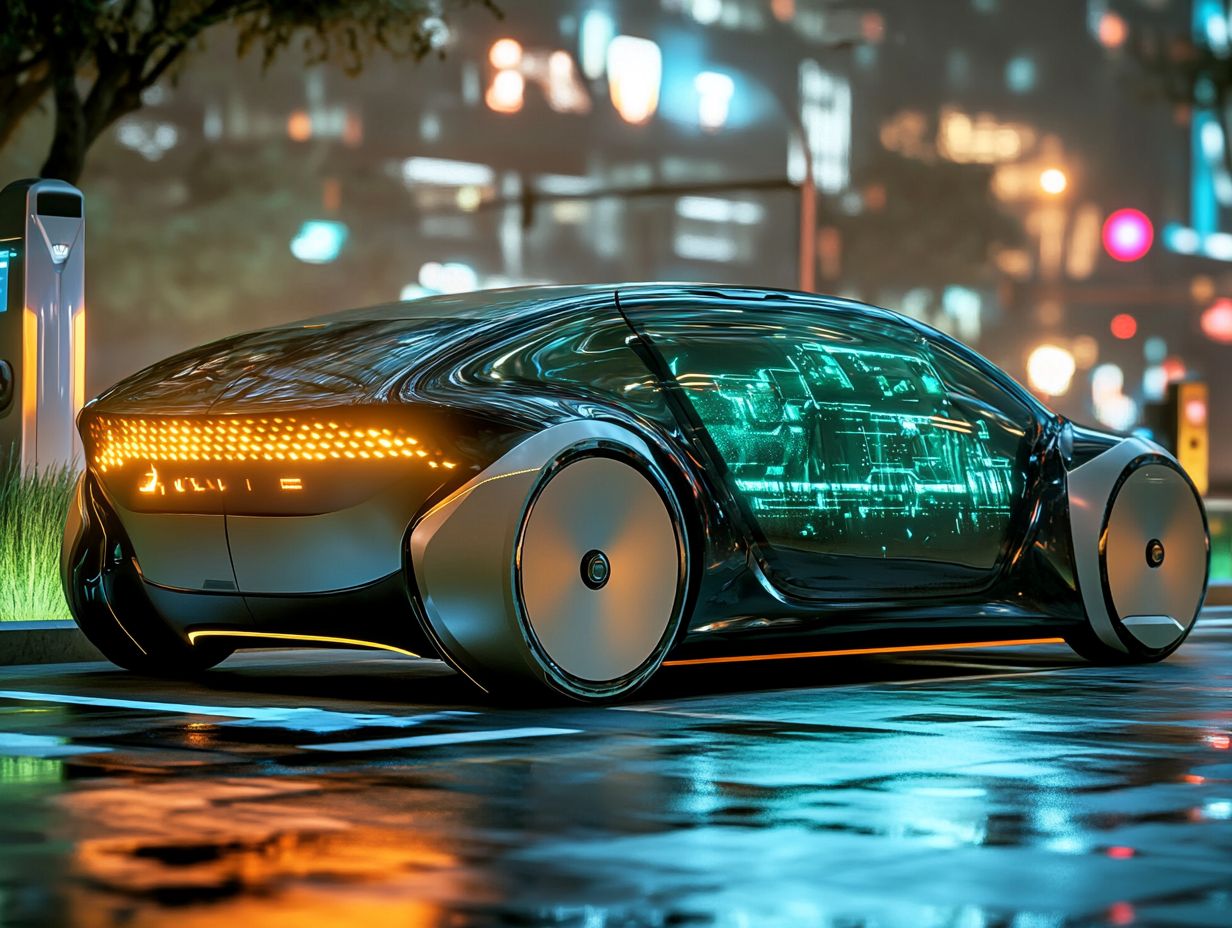
The enhanced connectivity features in electric vehicles, especially those in Tesla models, are transforming your driving experience by integrating advanced dashboard features that seamlessly connect with your smartphone and smart home devices.
These innovations enable you to control various functions directly from your mobile app, whether it’s pre-conditioning the cabin temperature or checking the charging status. With over-the-air updates, your vehicle s software stays up-to-date, introducing new features and boosting performance all without the hassle of a dealership visit.
Real-time navigation is another crucial aspect, offering live traffic updates and route adjustments that lead to a smoother, more efficient driving experience. These features make your daily driving easier and embody the rise of interactivity and convenience that today s modern transportation demands.
15. Government Incentives and Support for EVs
Government incentives and support for electric vehicles, such as a federal tax break that reduces the cost of electric vehicles, are pivotal in encouraging you to embrace electric cars, making them financially accessible to a wider audience.
These incentives manifest in various ways, like rebates applied at the point of sale, which effectively lower the purchase price, and tax credits that enable you to recoup some of the cost when you file your annual taxes. Such financial advantages not only ease the burden of upfront expenses associated with electric vehicles but also entice potential buyers like yourself who might be hesitant due to perceived costs.
These incentives fuel growth in the electric vehicle market, creating a ripple effect that prompts manufacturers to innovate and broaden their offerings, ultimately benefiting a diverse range of consumers.
What Are the Main Benefits of Owning an EV?
Owning an electric vehicle (EV) brings many benefits. These advantages enhance your driving experience and align with your values.
You could save an impressive $800 to $1,000 annually on fuel costs since electricity is often cheaper than gasoline. EVs also have fewer moving parts, helping you enjoy lower maintenance expenses some reports suggest savings of up to 30% over time compared to traditional vehicles.
The impact on emissions is also significant. Switching to electric vehicles could reduce greenhouse gas emissions by as much as 70% in urban areas.
These compelling advantages are driving a notable increase in adoption rates. By 2030, forecasts suggest that electric vehicles will account for nearly 30% of new car sales worldwide.
What Are the Potential Drawbacks of EVs?
Electric vehicles offer numerous benefits, but there are potential drawbacks. Range anxiety and limited charging infrastructure may make you hesitant to switch from traditional gasoline vehicles.
Charging times are often longer than the quick refueling stops required for gasoline cars. You might worry about finding a charging station when you need one, especially on longer trips.
Performance issues can also arise in colder climates, where battery life may be affected. Manufacturers are addressing these concerns by expanding fast-charging networks and investing in advanced battery technology.
Innovations are transforming the landscape of electric vehicle adoption. This makes switching to an EV increasingly appealing.
How Can EVs Help Combat Climate Change?
Electric vehicles are crucial in the fight against climate change. They help reduce greenhouse gas emissions through their zero-emissions operation.
Unlike traditional gasoline vehicles that release harmful pollutants, EVs operate quietly, producing no tailpipe emissions. This advantage is especially beneficial in urban areas where smog and respiratory issues are prevalent.
By adopting electric vehicles more broadly, you can greatly reduce your carbon footprint. This transition also encourages the use of renewable energy, contributing to a more sustainable energy ecosystem.
What Are the Predictions for the Future of EVs?
Predictions show remarkable growth for electric vehicles. This is driven by advancements in technology, increased consumer adoption, and supportive government policies.
As you consider upcoming breakthroughs like enhanced battery technologies the appeal of electric mobility strengthens. The rise of autonomous driving capabilities will also revolutionize your commuting experience.
Market trends reflect a shift in consumer preferences, with more people prioritizing sustainability. The automotive sector is ready for a transformation to meet the needs of an eco-conscious society that values performance and responsibility.
What Are the Factors Driving the Growth of EVs?
Several factors are driving interest in electric vehicles. These include a growing desire for eco-friendly options, favorable government incentives, and an impressive charging infrastructure.
As awareness about climate change rises, many consumers are choosing cleaner alternatives to traditional gasoline-powered cars. Recent studies show that the electric vehicle market is booming, with growth projected to exceed 22% in the next decade, highlighting a clear shift in consumer preferences.
This transition is reinforced by government policies offering enticing tax credits and rebates, making the switch to electric vehicles even more appealing. Manufacturers are investing heavily in technology and infrastructure to boost battery efficiency and range, ensuring they meet evolving demands.
As companies refine their offerings, the competitive landscape transforms, placing innovation and affordability front and center in the market.
Frequently Asked Questions
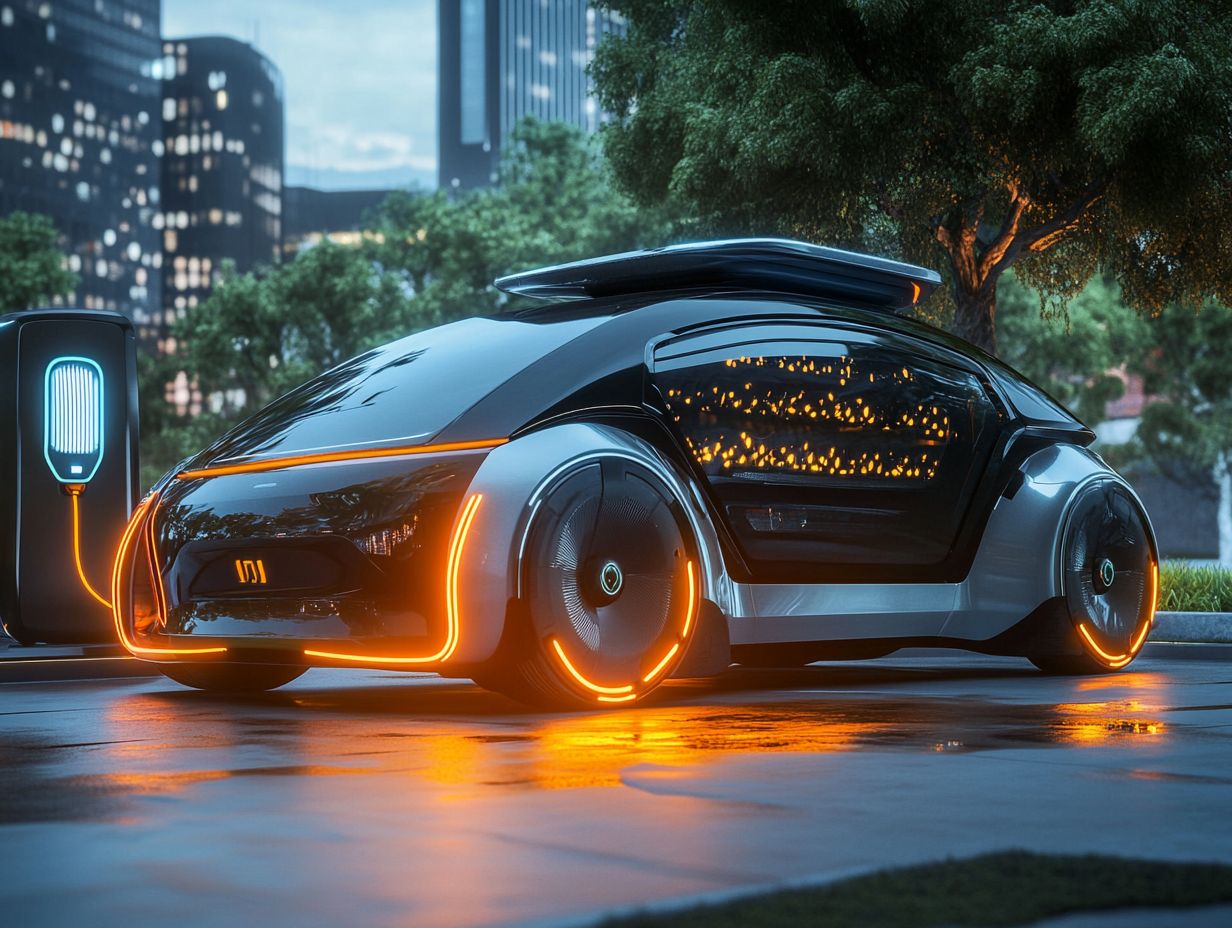
What are some of the top features of 2024’s EV models?
2024’s EV models come packed with exciting features. Expect top electric vehicle innovations that offer longer driving ranges and faster charging times!
Will the driving range of 2024’s EV models be significantly longer?
Yes, advancements in battery technology are expected to increase the driving range of 2024’s EV models, making them more practical for longer distance travel.
How will the charging times of 2024’s EV models compare to current models?
The charging times of 2024’s EV models are expected to be significantly faster due to advancements in battery technology and charging infrastructure.
What safety features can we expect to see in 2024’s EV models?
2024’s EV models are expected to have advanced safety features, including automatic emergency braking, lane departure warning, and blind spot detection, among others. For those interested in the latest options, the top 5 electric SUVs of 2024 will showcase these innovations.
Will there be any improvements in battery technology for 2024’s EV models?
Yes, 2024’s EV models are expected to feature improved battery technology, such as solid-state batteries, offering longer range and faster charging times. For families considering an electric vehicle, exploring the top 5 EVs for families in 2024 can provide valuable insights.
How will connectivity options in 2024’s EV models be different from current models?
2024’s EV models are expected to have enhanced connectivity options, allowing features such as over-the-air updates, remote vehicle monitoring, and integration with smart home systems, making the top luxury EVs to consider in 2024 even more appealing.


